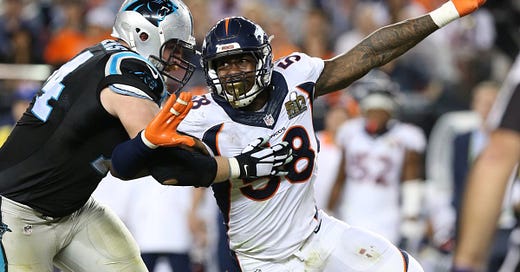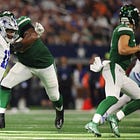Creating a Pass Rush Move Classification Model
Pass Rush Moves can heavily influence the leverage a pass rusher creates
Leverage Angle alone is a solid metric to measure the quality of positioning between pass rushers and pass blockers relative to the quarterback. But not all pass rushes have the same intent. To simplify this point to an extreme level (pass rush moves are more complicated than three categories) — some pass rushers utilize outside moves, some inside, and others bullrush the blocker across from them. Each of these have their own distinct characteristics that allow them to gain or minimize leverage.
For example, players like Rashan Gary who are known for utilizing bullrushes at a high rate are penalized by raw Leverage Angle outputs as bullrushes drive into the middle of the OT’s chest rather than work around the blocker.
Creating a Pass Rush Move Classification Model
In order to conduct this research I first had to create a Pass Rush Move Classification Model (PRMM) to get pass rush move labels for individual pass rushes. I utilized charting data that buckets pass rush moves into Inside, Outside, and Bullrush. While labeling is not as granular as a rip, club, cross-chop, swim, etc. it at least gives us an idea of the type of move a pass rusher is using. The main issue here is that the pass rush moves were only provided on pressures. This is likely because non-pressures aren’t as clean and it may be difficult to decipher between moves.
But I wanted to give it a try and see how well my model could perform. I used variables like pass rusher position, speed, leverage angle, movement direction, distance from LOS, horizontal distance from ball, difference in horizontal distance with matchup, matchup distance, etc. to name a few. I took those variables at the snap, half second, one second, one and a half second, two second, and two and a half second marks and also lagged on some variables to get more data points across frames along the pass rusher’s path.
I utilized a random forest model for simplicity, but a neural network might be the best option if I had to spend more time on building the most accurate model possible.
I split the data into pressures and non-pressures as only pressures had the pass rush move detail included in the dataset. I then split the pressures into the train and test data.
Confusion Matrix Results
I ended up going with a model that was ~80% accurate on the test data. Which I think is pretty solid given that we’re only working with columns created from X, Y frames. The data doesn’t have the ability to assess hand placement/use of hands, intention of a move versus what’s actually happening (i.e. a player trying to go inside but the OT is keeping him from working that way).
Below are the statistics by class — Bullrush, Inside, and Outside moves.
Statistics by Class:
Class: Bullrush Class: Inside Class: Outside
Sensitivity 0.7333 0.7857 0.8417
Specificity 0.9136 0.8533 0.9223
Pos Pred Value 0.7480 0.7473 0.8716
Neg Pred Value 0.9074 0.8782 0.9029
Prevalence 0.2591 0.3557 0.3852
Detection Rate 0.1900 0.2795 0.3242
Detection Prevalence 0.2541 0.3740 0.3720
Balanced Accuracy 0.8235 0.8195 0.8820Bullrush and Inside moves are more likely to be confused with each other compared to being confused with Outside moves because of the inherent nature of the data like I mentioned before. Outside moves have a more distinct path around the OT — whether running the arc or attacking the outside half-man relationship — while Inside moves and Bullrushes usually have to get into the middle of the blocker’s body.
Bullrush:
More likely to be confused with Inside (17.7%) than with Outside (7.1%).
Inside:
More likely to be confused with Bullrush (14.6%) than with Outside (12.0%).
Outside:
Less likely to be confused with Bullrush (4.5%) or Inside (7.9%) compared to the confusion between Bullrush and Inside.
Predictions & Results
Next I ran the model on the non-pressure data. I’m not going to take these results as gospel as I’m aware of the issues of training and testing on pressures only and then predicting on a dataset of non-pressures. I’m sure there are plenty inside moves and bullrushes that are confused with one another, especially on non-pressures given how the pass rusher can be stonewalled and taken off his intended path. If I had the resources I’d probably want to chart out 250-500 non-pressures to add into the train and test data set. But for now this is the best I’ve got and believe it touches the surface of what is possible moving forward for more granular analysis to present coaches and players for their development and game preparation (more on that in future posts).
All Pass Rushes
pass_rush_move max_speed_two_half_sec leverage_angle pressure_pct
Bullrush 8.80 37.7 23.3
Inside 8.18 51.6 15.5
Outside 9.21 78.4 26.8Pressures
pass_rush_move max_speed_two_half_sec leverage_angle
Bullrush 9.03 45.6
Inside 8.82 80.9
Outside 9.88 107.0Non-Pressures
pass_rush_move max_speed_two_half_sec leverage_angle
Bullrush 8.74 35.3
Inside 8.06 46.3
Outside 8.97 67.9I’m satisfied with these summary results as well considering pressures and non-pressures are correlated in terms of max speed within 2.5 seconds and leverage angle. Where Outside moves create the highest max speeds and leverage angle, followed by Bullrushes, and then Inside moves for max speed and Inside moves and Bullrushes for leverage angle. The latter is intuitive because Bullrushes are going through the blocker which causes a straighter path between the three points — pass rusher, blocker, and QB.
As for the distribution by pressure class — I think these results are also a sign I’m on the right track. Inside moves make up a majority of non-pressures (and after going through and validating plays there are definitely some Bullrushes gone awry that are included) — which makes sense given the characteristics of Inside moves relative to the other two move categories. Inside moves are slower and create less leverage while also working into more bodies of the offensive line.
Bullrushes are utilized less, but leverage angle matters slightly less for them because they’re relying on their speed converting to power to push their matchup back into the QB rather than getting around.
Outside moves create higher speeds and leverage so I believe this also makes sense as to why they’re more prevalent on pressures than non-pressures.
Leaders by Pass Rush Move %
Rashan Gary finished sixth in bullrush rate if anyone was wondering from the beginning of the article. I’d love for any pass rush film experts to look over the results to confirm if these leaders make sense from the eye test side of things.
Future Applications
The applications for this model are deep and I’ll be exploring the potential of what I can bring to an NFL club via advance scouting, player personnel acquisition, and player development through the Pass Rush Move Model. Those ideas include…
EDGE vs OT Matchup Reports
Most Frequent Moves by situation, alignment
Pass Rush Move Sequencing and Decay
Tapping into an EDGE rusher’s potential









